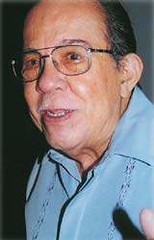This sad state of the country’s film and broadcast industry was to be the background scenario when Negros Oriental’s very own Eddie Romero was honored as the National Artist for Cinema and Broadcast in 2003.

The honor may have been given at the wrong time, and was in fact, long overdue. But Eddie Romero being awarded with the country’s highest honor in culture and the arts means a lot to us anyway. For students in this University Town, it is a call to discover his gifts of inspiration and sense of nationalism through the knowledge of his classic works.
Eddie Romero’s touch was a major force that led to Phillippine Cinema’s golden age in 1976. It was his Ganito Kami Noon, Paano Kayo Ngayon? that gave the Philippine film industry a sense of national identity. The use of local color through production design and musical score achieved an Amorsolo light in Philippine cinema. His Kamakalawa, which had the Negros Oriental riverbanks and mountain slopes as setting, was a manifestation of his love for the folkloric Philippines. With all of these, a distinction was made concrete.
It was a delight that through his Alma Mater (Silliman University High School in 1940) the University Town was able to honor him with an important homecoming. On February 11 at the Luce Auditorium, National Artist Eddie Romero was the Guest Speaker for Silliman University Honors Day.
He started his speech with a recollection of the one-act comedy he wrote. Sixty-four years ago when he was still a sophomore liberal arts student, “History is Made in Bed” was mounted on Silliman Hall stage. This was after he sold his first screenplay to a film company in Manila. Knowing now that he started so young as a playwright, and with Dumaguete as the cradle of his early works is truly a great inspiration.
Literary artist and film critic Ian Rosales Casocot describes Romero as “the quintessential storyteller” and “a film artist who is known for going beyond didacticism to tell, in his films, stories about people in the midst of the richness and everyday complexities of their lives.” He further states that among the more than 70 Romero films are masterpieces that “have enriched the Philippine cinema with his deft artistry and activism”. His creative energy has gone as far as major international projects that have “contributed to the pantheon of Hollywood cult classics that have influenced such filmmakers as Quentin Tarantino.”
When invited to share his insights on the Philippine film industry with a classroom session with MassCom students and the Weekly Sillimanian staff, Eddie Romero pointed out the “need for truly passionate film artists” that will not compromise their ideas with trends and commercial pressures.
He also shared that government tax and the lack of support from politicians made it impossible for a director to have all the resources needed for an outstanding production.
There is so much to learn from this National Artist for Cinema and Broadcast. Even his closing statement on Honors Day reveals an important call: “We are all dependent on one another, whether we want to be or not. The quality of a human life can only be measured by the quality of its response to this inescapable need. It is the totality of that response that determines whether nations flourish or wither away. I cannot bear the thought of not having a country to be proud of. Bit there is nothing I fear more than deceiving myself. That is my story for today.”
No comments:
Post a Comment